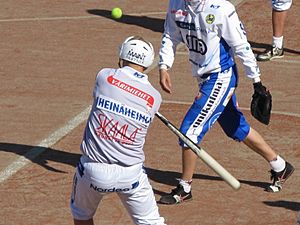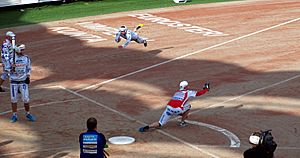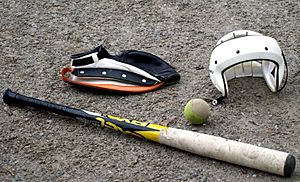Pesäpallo facts for kids
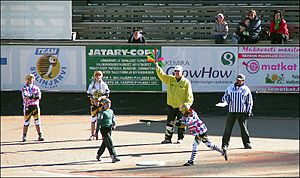
Girls playing pesäpallo in Siilinjärvi in 2006.
|
|
| First played | 1920s |
|---|---|
| Characteristics | |
| Team members | 9 (on defense) 12 (on offense) |
| Type | Bat-and-ball |
| Equipment | Ball, bat, gloves, helmet, pitching plate |
| Presence | |
| Olympic | Demonstrated in 1952 |
| World Games | Invitational in 1997 |
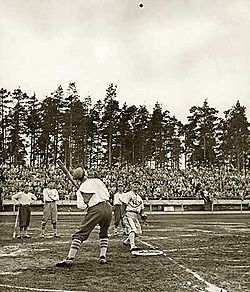
Pesäpallo (also known as Finnish baseball or pesis) is a super fun and fast-paced bat-and-ball sport. It's often called the national sport of Finland! You can also find people playing it in countries like Germany, Sweden, Switzerland, Australia, and even parts of Canada.
Pesäpallo is a mix of traditional bat-and-ball games and North American baseball. It was invented in the 1920s by a person named Lauri "Tahko" Pihkala. Over the years, pesäpallo has changed and become very popular.
The main idea of pesäpallo is like baseball. The team on offense tries to score points by hitting the ball and running around bases. The team on defense tries to get the hitters and runners out. A big difference is how the ball is pitched. In pesäpallo, the ball is thrown straight up into the air. This makes it easier to hit the ball and control where it goes. This adds more exciting choices and strategies to the game! The defense has to guess what the batter will do and plan their moves.
The team manager is very important in pesäpallo. They use a special fan with different colors to give signals to the players on offense. The defense also gets instructions from their manager and hand signals from players on the field.
Pesäpallo was even shown at the 1952 Summer Olympics in Helsinki, Finland. It was a special "demonstration sport" there.
Contents
How to Play Pesäpallo
A normal pesäpallo game has two parts, called "periods." Each period has four "innings." A team wins a period if they score more points in their turn at bat. If the periods end in a tie, they play an extra inning. If it's still tied, they have a special round where each team tries to get a player home from third base.
During an inning, both teams take turns. One team plays offense (batting) and the other plays defense (fielding).
Players on the Field
The defensive team has nine players on the field. The offensive team has nine regular batters. They can also use three "jokers" (extra batters) during their turn. The offensive team keeps batting until three players are out. Or, if everyone in the batting order has had a turn without at least two points being scored.
The batter and the pitcher stand facing each other at the home base. The pitcher throws the ball straight up into the air. It must go at least one meter (about 3 feet) above their head.
Hitting and Running
The batter gets three chances to hit the ball. They don't have to run to first base if they hit the ball fairly. They can use all three chances first. If the batter hits a "foul ball" on their third chance, they are out. But other runners on base can still keep going.
If the pitcher throws two "bad pitches" (called a "ball"), the batter gets to walk to first base. This only happens if no one else is on base. If there are runners on base, the runner closest to scoring gets to move to the next base for every bad pitch after the first two. A pitch can be bad if it doesn't land on the plate or isn't thrown high enough.
A hit is "foul" if the ball lands outside the playing area. Runners cannot move forward on a foul hit. If a fielder catches the ball before it hits the ground, it's a "catch." Any runners who were trying to move on that play are "caught." Caught players leave the field, but they don't count as an "out."
A runner is safe on a base if they touch the base area before the ball gets to a fielder there. If the ball gets to the base first, the runner is "out" and leaves the field. The batter is also out if their third hit is foul. A runner on a base must move to the next base if another runner safely reaches their base.
Scoring Points
A team scores a "run" when a runner safely gets back to the home base. This happens after they have run through all three field bases. If a batter hits the ball and runs all the way to third base on that same hit, it's a "home run!" After a home run, they can stay on third base. Then they can try to score again later as a regular runner.
What Makes Pesäpallo Different from Baseball?
Pesäpallo has some cool differences from baseball:
- Ball Bounce: The first bounce of the ball is very important. It must bounce inside the playing area. It can then roll out of bounds and still be in play. If a player hits the ball very high and far, like a home run in baseball, it might be a foul in pesäpallo! This makes the game more about smart hitting. All home runs in pesäpallo are "inside-the-park" home runs.
- Catching the Ball: Catching a ball in the air doesn't mean the batter is out. Instead, any runners who were moving when the ball was caught must try to reach the next base. If they make it, they go back to home base with no penalty. If they don't make it, they are out.
- Pitching Plate: Instead of a batter's box, there's a round "pitching plate" at home base. It's about 0.6 meters (2 feet) wide. All other players on the batting team stand in a half-circle near the batter.
- Hitting the Ball: Players can usually hit the ball easily. So, the goal isn't just to hit it, but to choose the best type of hit and aim it well. There are many types of hits:
- Snap (short) hit: This is used to move fast runners between bases. It's hit to avoid defensive players and often spins hard.
- Fly hit: This is an intentional high hit meant to be caught. It's used to let faster runners move ahead.
- High drive: This hit aims to land between the middle and outer parts of the field. It has a top spin and is great for scoring.
- Bouncer: This hit is used for fast runners. It's hit very hard downwards right next to the front arc. It's aimed towards the base the runner is leaving or to the center. It's a tricky hit that only advanced players use.
- Home Runs: A home run happens when a batter reaches third base on their own fair hit. After hitting a home run, the player stays at third base and can score again later as a regular runner.
- Walking: It takes fewer bad pitches to get a "walk." If no one is on base, one bad pitch gives a walk. If there are runners, two bad pitches give a walk. After two bad pitches, every extra bad pitch gives another walk. A walk moves the runner closest to scoring. If a runner is at third base, they score a point!
- No Forced Advance: A fair hit doesn't force the batter to run. They can use all three chances to hit before they have to become a runner. A pitch counts as a strike if the batter swings or if the umpire says the pitch was good.
- Force Outs: If a runner is off a base and a defensive player has the ball at the next base, the runner is out.
- Base Layout: The bases are not in a diamond shape like baseball. Players have to run in a zig-zag pattern across the field.
- Base Areas: When entering a base or home base, the runner just needs to cross the line of the base. There aren't big cushion bases like in baseball. The bases are larger areas marked by lines on the field. Fielders also just need a foot in the base area to make an out.
- Signals: The attacking team uses a special fan with different colors to tell runners when to move. The coach holds the fan, and the color pattern is decided before the game.
Pesäpallo Players
The team playing defense has nine players on the field. The pitcher stands at home base. A catcher plays in the infield near second base. Each of the three bases has a baseman. There are also two shortstops near second and third bases. Two outfielders cover the far part of the field. Players can move around and position themselves wherever they want. They change positions based on what kind of hit they expect. This often depends on where the offensive team's lead runner is. Teams can even have special plans for certain batters.
The team playing offense has nine batters and three extra batters called jokers. Regular batters must bat in a set order. But joker batters can bat at any time!
Today, players usually have special roles in the batting order. Fast runners often bat first. Then come players who are good at moving runners between bases. After them is a player who specializes in scoring runs. Players from numbers 6 to 9 often form another attacking group. Jokers are usually either "batting jokers" (strong hitters who score lots of points) or "runner jokers" (fast runners who are good at moving around the field).
Both teams have a manager (called a pelinjohtaja). The team captain, who is one of the players, tries to win a special coin toss (called hutunkeitto). This toss decides which team gets to choose if they want to start on offense or defense. The manager is like a coach and doesn't play in the game itself.
Pesäpallo Equipment
Helmet
Every player on offense must wear a helmet. If a player bats without one, their team can get an out. Also, all fielders except the pitcher and outfielders must wear helmets.
Glove
Players use a special glove to help catch the ball when playing defense. The pesäpallo glove looks and feels different from a baseball glove. It's more like a hockey goalie's glove. It's made of thick leather, and some parts might use synthetic materials. The glove has padding to protect the hand.
The ball is caught in the glove's pocket between the thumb and index finger. Sometimes the ball hits the palm, so a good glove helps prevent injuries. Other tools for catching the ball are not allowed.
Bat
The bat is a round, tapered stick. Long ago, pesäpallo bats were made of wood. But they broke easily because the ball is heavy. Now, wooden bats are only used in kids' games. Adult bats are made from a mix of glass fiber and carbon fiber.
Bats come in different weights, lengths, and flexibility. The longest bat can be 100 centimeters (about 39 inches) long. For kids' balls, the bat can be up to 90 centimeters (about 35 inches) long.
The weight of the bat is very important. Bats used in top games usually weigh between 580 and 620 grams (about 20-22 ounces). The heaviest bats are over 650 grams (about 23 ounces). Only strong players, like batting jokers, use these. Younger players usually use bats that weigh less than 400 grams (about 14 ounces). The part of the bat that hits the ball is usually 56 millimeters (about 2.2 inches) wide.
Spikes
Players don't have to wear spiked shoes, but they help a lot! Spikes help players move quickly, especially on modern artificial grass fields, which can be slippery. This artificial turf is different from what's used on soccer fields.
Not many companies make spikes just for pesäpallo. So, many players use regular running spikes. Some shoes have spikes at the heel, but most are under the ball of the foot. Usually, there are seven spikes on a shoe, and they are 3–15 millimeters long. On artificial turf, spikes can be no longer than 6 millimeters.
Ball
The pesäpallo ball is yellow. It's about 21.60 to 22.20 centimeters (about 8.5-8.7 inches) around. The weight of the ball changes depending on who is playing:
- Men's ball: 160–165 grams (about 5.6-5.8 ounces)
- Women's ball: 135–140 grams (about 4.8-4.9 ounces)
- Junior ball: 95–100 grams (about 3.4-3.5 ounces)
Pesäpallo Competitions
The top championship league in Finland is called Superpesis. There are separate leagues for men and women. The second level is called Ykköspesis. The third level has local leagues known as Maakuntasarjat.
Teams from all three levels can also play in the yearly Finnish open cup, called Suomensarja.
There are also junior leagues for players under 21. These are called Poikien Superpesis for boys and Tyttöjen Superpesis for girls.
A Pesäpallo World Cup is held every three years for international teams. In 2006, the World Cup was in Munich, Germany. Teams from Australia, Finland, Germany, and Sweden played. The next World Cup was in 2009 in Pori, Finland. Teams from Australia, Finland, Germany, Sweden, and Switzerland took part. In 2012, the World Cup was on the Gold Coast of Australia. Australia, Finland, and "Team Europe" played. The 2015 World Cup was in Lucerne, Switzerland, with teams from Australia, Germany, Finland, and Switzerland.
See also
 In Spanish: Pesäpallo para niños
In Spanish: Pesäpallo para niños
- Finnish pesäpallo match-fixing scandal
- Superpesis
Images for kids


